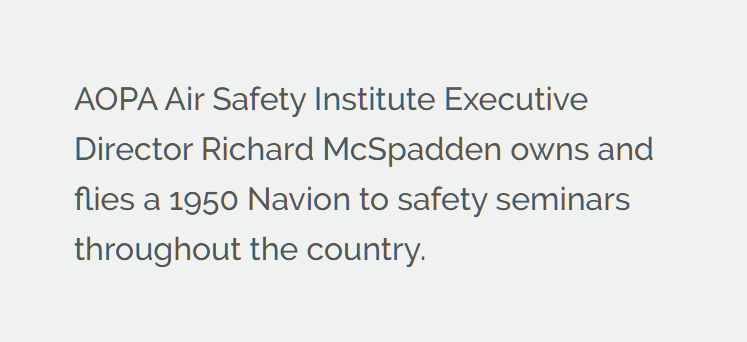 Why Do Good Pilots Make Bad Decisions?
Why Do Good Pilots Make Bad Decisions?
by richard mcspadden
NOTE: This article was originally published in AOPA PILOT Magazine and is reposted here with permission.
This year marked a disappointing first in my safety career. I attended a type club safety conference, and at the conclusion of the conference, on the same day I departed for Frederick Municipal Airport in Maryland, one of the type club members crashed on his flight home and died. Crashed. On the way home from a type club safety conference.
The NTSB is still investigating, but from online tracking sources, it appears the pilot departed in his high-performance, single-engine experimental airplane and was attempting to fly below the weather at approximately 1,000 feet agl, while flying in excess of 200 knots when he crashed. This flight profile is commonly called “scud running,” which escalates in difficulty with increased speed. It was a tragic, ironic end to the safety conference.
Typical of type club fly-ins, the group began trickling in early in the week from all over the country. They reconnected with each other, many of them obviously friends for decades, sharing the joys of their airplane and showing off new upgrades. Type clubs are everything good about general aviation: a wealth of knowledge, exceptional and specific instruction, healthy culture, and social events that help build lifelong friendships.
 The conference for this energetic club began mid-week with safety seminars, panels, and deep-dive tech talks. Some took the opportunity for some flying and flight reviews on the side. We enjoyed a hangar dance and barbecue Friday night while strolling the flight line and ogling especially gorgeous airplanes and curious airplanes with unique modifications. This is especially interesting with experimental aircraft type clubs.
The conference for this energetic club began mid-week with safety seminars, panels, and deep-dive tech talks. Some took the opportunity for some flying and flight reviews on the side. We enjoyed a hangar dance and barbecue Friday night while strolling the flight line and ogling especially gorgeous airplanes and curious airplanes with unique modifications. This is especially interesting with experimental aircraft type clubs.
Saturday was a full day of seminars to include a talk on “Why Good Pilots Make Bad Decisions.” The discussion stems from my experience losing friends in both military and GA flying, and in reading accidents of highly experienced and obviously skilled pilots who made uncharacteristically poor decisions. Seeing people I respect make a poor decision with devastating consequences made me realize I could be susceptible to the same peril. “Why Good Pilots Make Bad Decisions” acknowledges that we are all susceptible to poor decisions and focuses a discussion around how to avoid them.
The discussion pulls from two books dealing with decision making: Think Again, published by the Harvard Business Review, and Thinking Fast and Slow, by Daniel Kahneman. Both books shed light on how the brain operates and explain that despite our best efforts, our decision-making process is sometimes hopelessly flawed. We are prone to make quick decisions, more than optimum decisions, and we place too much faith in our intuition or our “gut feel.” We are powerfully susceptible to biased logic when we have a keen self-interest at stake. Once we make a decision, we tend to over-value data that supports our decision and undervalue data that suggests we should reconsider. In an aviation setting, the brain’s processing—so vital to the thousands of decisions we make every day—can lead to an oversight of critical information and incite poor decisions. We must be aware and on guard.
At the banquet Saturday evening, many of us shared observations about the weather, which had been better than forecast all weekend. We awoke Sunday to surprisingly deteriorating conditions. A line of weather moving from the southwest had intensified and would arrive overhead in just a couple of hours. We were already experiencing mist and light rain. The environment was set with just the kind of elements we talked about in the seminar Saturday that can lead to imprudent decisions.
Sunday departures are already prejudiced by a desire to put a neat end to the week, get home, and make it to work the next day. We’ve already said our goodbyes, checked out of the hotel, and turned in the rental car; we’ve made our decision and it’s time to go. We have an extreme bias to execute on our decision to get home and we have a difficult time stepping back to review our entire range of options and reconsider. The approaching weather that Sunday added more stress and more self-interest, since the system appeared to be the kind likely to result in a long delay. Either we departed that morning, or we were likely to be stuck until Tuesday.
The mishap pilot chose to depart in the direction of the encroaching weather. We don’t know what his thinking was, or his plan. It will take close to two years before the NTSB releases a probable cause that may shed light on whether or not the pilot’s decisions were contributing factors. Until then, we can ponder the setting, put ourselves in the same position, and ask what protections we have in place to strengthen our decisions—especially in capricious situations.
Go fly. And be especially cognizant of your decision-making on Sunday fly-outs.
Richard McSpadden is the Executive Director of AOPA Air Safety Institute. He leads AOPA’s Air Safety Institute, committed to reducing General Aviation mishaps by providing free educational resources and supporting initiatives that improve General Aviation safety and grow the pilot population. For comments and questions on the post contact LOBO via email: info [at] lancairowners.com
